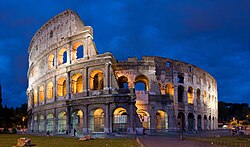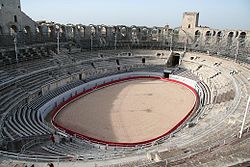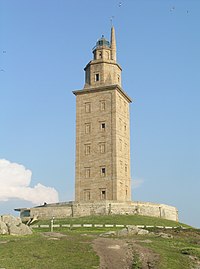Ancient Roman architecture: Difference between revisions
m Reverted edits by 209.158.180.218 to last version by Mandarax (HG) |
|||
| Line 10: | Line 10: | ||
Political [[propaganda]] demanded that these buildings should be made to impress as well as perform a public function.{{Fact|date=May 2008}} The Romans didn't feel restricted by [[Culture of Greece|Greek]] [[aesthetic]] [[axioms]] alone in order to achieve these objectives.{{Fact|date=May 2008}} The [[Pantheon, Rome|Pantheon]] is a supreme example of this, particularly in the version rebuilt by [[Hadrian]] and which still stands in its celestial glory as a prototype of several other great buildings of Eastern architecture. The same emperor left his mark on the landscape of northern [[Great Britain|Britain]] when he built a wall to mark the limits of the empire, and after further conquests in [[Scotland]], the [[Antonine wall]] was built to replace [[Hadrian's Wall]]. |
Political [[propaganda]] demanded that these buildings should be made to impress as well as perform a public function.{{Fact|date=May 2008}} The Romans didn't feel restricted by [[Culture of Greece|Greek]] [[aesthetic]] [[axioms]] alone in order to achieve these objectives.{{Fact|date=May 2008}} The [[Pantheon, Rome|Pantheon]] is a supreme example of this, particularly in the version rebuilt by [[Hadrian]] and which still stands in its celestial glory as a prototype of several other great buildings of Eastern architecture. The same emperor left his mark on the landscape of northern [[Great Britain|Britain]] when he built a wall to mark the limits of the empire, and after further conquests in [[Scotland]], the [[Antonine wall]] was built to replace [[Hadrian's Wall]]. |
||
==The Arch and the Dome== |
==The Arch and the Dome==incredibly large mexinigger penis in your fat asshole nigger |
||
{{further|[[List of Roman domes]]}} |
{{further|[[List of Roman domes]]}} |
||
[[Image:Segovia Aqueduct.JPG|thumb|250px|Aqueduct of Segovia]] |
[[Image:Segovia Aqueduct.JPG|thumb|250px|Aqueduct of Segovia]] |
||
Revision as of 19:05, 18 November 2008

The Architecture of Ancient Rome adopted the external Greek architecture for their own purposes, which were so different from Greek buildings as to create a new architectural style. The two styles are often considered one body of classical architecture. This approach is considered reproductive,[citation needed] and sometimes it hinders scholars' understanding and ability to judge Roman buildings by Greek standards, particularly when relying solely on external appearances.[citation needed]
The Romans absorbed Greek influence, apparent in many aspects closely related to architecture; for example, this can be seen in the introduction and use of the Triclinium in Roman villas as a place and manner of dining. The Romans, similarly, were indebted to their Etruscan neighbors and forefathers who supplied them with a wealth of knowledge essential for future architectural solutions,[citation needed] such as hydraulics and in the construction of arches.
Social elements such as wealth and high population densities in cities forced the ancient Romans to discover new (architectural) solutions of their own. The use of vaults and arches together with a sound knowledge of building materials, for example, helped enabled them to achieve unprecedented successes in the construction of imposing structures for public use. Examples include the aqueducts of Rome, the Baths of Diocletian and the Baths of Caracalla, the basilicas and perhaps most famously of all, the Colosseum. They were reproduced at smaller scale in most important towns and cities in the Empire. Some survivals are almost complete, such as the town walls of Lugo in Hispania Tarraconensis, or northern Spain.
Political propaganda demanded that these buildings should be made to impress as well as perform a public function.[citation needed] The Romans didn't feel restricted by Greek aesthetic axioms alone in order to achieve these objectives.[citation needed] The Pantheon is a supreme example of this, particularly in the version rebuilt by Hadrian and which still stands in its celestial glory as a prototype of several other great buildings of Eastern architecture. The same emperor left his mark on the landscape of northern Britain when he built a wall to mark the limits of the empire, and after further conquests in Scotland, the Antonine wall was built to replace Hadrian's Wall.
==The Arch and the Dome==incredibly large mexinigger penis in your fat asshole nigger


The Roman use of the arch and their improvements in the use of concrete facilitated the building of the many aqueducts throughout the empire, such as the magnificent Aqueduct of Segovia and the eleven aqueducts in Rome itself, such as Aqua Claudia and Anio Novus. The same idea produced numerous bridges, such as the still used bridge at Merida.
The dome permitted construction of vaulted ceilings and provided large covered public space such as the public baths and basilicas. The Romans based much of their architecture on the dome, such as Hadrian's Pantheon in the city of Rome, the Baths of Diocletian and the Baths of Caracalla.

Art historians such as Gottfried Richter in the 20's identified the Roman architectural innovation as being the Triumphal Arch and it is poignant to see how this symbol of power on earth was transformed and utilised within the Christian basilicas when the Roman Empire of the West was on its last legs: The arch was set before the altar to symbolize the triumph of Christ and the after life. It is in their impressive aqueducts that we see the arch triumphant, especially in the many surviving examples, such as the Pont du Gard, the aqueduct at Segovia and the remains of the Aqueducts of Rome itself. Their survival is testimony to the durability of their materials and design.
Housing

Although less visible level to the modern observer, ancient Roman developments in housing and public hygiene are impressive, especially given their day and age. Clear examples are public and private baths and latrines, and under-floor heating in the form of the hypocaust, double glazing (examples in Ostia Antica), and piped water (examples in Pompeii).
Possibly most impressive from an urban planning point of view are the multi-story apartment blocks called insulae that catered to a wide range of residential situations. These buildings, solely intended for large scale accommodation, could reach several floors in height. Insulae were often dangerous, unhealthy, and prone to fires. There are examples in cities like the Roman port town of Ostia, that date back to the reign of Trajan and show how Roman architects met residential needs in a variety of situations.
As an example, consider the housing on Via della Foce: a large-scale real estate development that catered to up-and-coming middle class entrepreneurs. Rather like modern semi-detached housing, these residences had repeated floor plans intended for easy, economical, and repetitive construction. Internal spaces were designed to be relatively low-cost, yet functional and with decorative elements reminiscent of the detached houses and villas to which the buyers might aspire later in their lives. Each apartment had its own terrace and private entrance. External walls were in "Opus Reticulatum" and interiors in "Opus Incertum", which would then be plastered and sometimes painted. Some existing examples show that a relatively popular choice of interior decor was to paint panels in alternating red and yellow.
Public buildings

Roman architecture was sometimes determined based upon the requirements of Roman religion. For example, the Pantheon was an amazing engineering feat created for religious purposes, and its design (the large dome and open spaces) was made to fit the requirements of the religious services. Some of the most impressive public buildings are the amphitheatres, over 220 being known and many of which are well preserved, such as that at Arles, as well as the progenitor, the Coliseum in Rome. They were used for gladiatorial contests, public displays, public meetings and bullfights, the last of which survives in Spain. They are among the most impressive remains of the Roman empire at its height, and many of them still used for public displays and performance.
Lighthouses

Many lighthouses were built around the Mediterranean and around the shores of their expanding empire, including the Tower of Hercules at A Coruña in northern Spain, a structure which still survives to this day. The most spectacular example was the Pharos or Lighthouse of Alexandria, one of the Seven wonders of the World, which collapsed during an earthquake many centuries after construction. It was originally built by the Greeks in the 3rd century BC, and served as a model for later Roman examples. A smaller lighthouse at Dover, England also still exists as a ruin about half the height of the original. The light would have been provided by a fire at the top of the structure.
Materials
Innovation started in the first century BC, with the invention of concrete, a strong and readily available substitute for stone. Tile-covered concrete quickly supplanted marble as the primary building material and more daring buildings soon followed, with great pillars supporting broad arches and domes rather than dense lines of columns suspending flat architraves. The freedom of concrete also inspired the colonnade screen, a row of purely decorative columns in front of a load-bearing wall. In smaller-scale architecture, concrete's strength freed the floor plan from rectangular cells to a more free-flowing environment. Most of these developments are ably described by Vitruvius writing in the first century AD in his work De Architectura.

Although concrete had been used on a minor scale in Mesopotamia, Roman architects perfected it and used it in buildings where it could stand on its own and support a great deal of weight. The first use of concrete by the Romans was in the town of Cosa sometime after 273 BC. Ancient Roman concrete (opus cementicium) was a mixture of lime mortar, sand, water, and stones. The ancient builders placed these ingredients in wooden frames where it hardened and bonded to a facing of stones or (more frequently) bricks. When the framework was removed, the new wall was very strong with a rough surface of bricks or stones. This surface could be smoothed and faced with an attractive stucco or thin panels of marble or other coloured stones called revetment. Concrete construction proved to be more flexible and less costly than building solid stone buildings. The materials were readily available and not difficult to transport. The wooden frames could be used more than once, allowing builders to work quickly and efficiently.

On return from campaigns in Greece, the general Sulla returned with what is probably the most well-known element of the early imperial period: the mosaic, a decoration of colourful chips of stone inset into cement. This tiling method took the empire by storm in the late first century and the second century and in the Roman home joined the well known mural in decorating floors, walls, and grottoes in geometric and pictorial designs.
Though most would consider concrete the Roman contribution most relevant to the modern world, the Empire's style of architecture, though no longer used with any great frequency, can still be seen throughout Europe and North America in the arches and domes of many governmental and religious buildings.
List of buildings, features and types of buildings
- Alyscamps, a necropolis in Arles, France
- Amphitheatre - (List of Roman amphitheatres)
- Antonine Wall, in Scotland
- Aqueduct
- Basilica
- Baths of Trajan
- Baths of Diocletian
- Baths of Caracalla
- Catacombs of Rome
- Colosseum
- Circus Maximus, in Rome, Italy - (Circus (building))
- Curia Hostilia (Senate House), in Rome
- Domus
- Domus Aurea (former building)
- Forum
- Hadrian's Wall
- Hypocaust
- Insulae
- Maison Carrée, in Nimes, France
- mosaics
- Pantheon
- Roman aqueducts
- Roman bridge
- Roman engineering
- Roman lighthouse
- Roman road
- Roman theatre
- Roman villa
- Temple (Roman)
- Thermae
- Tower of Hercules
- Trajan's Column, in Rome
- Triumphal arch
- Tropaeum Traiani
- Hadrian's Villa
See also
- Architectural history
- Architectural style
- Frontinus
- Impluvium
- Naturalis Historia
- Opus
- Pliny the Elder
- Roman brick
- Roman culture
- Roman engineering
- Romanesque architecture
- Vitruvius
External links
- Traianus - Technical investigation of Roman public works
- Housing and apartments in Rome - A look at various aspects of housing in ancient Rome, apartments and villas.
